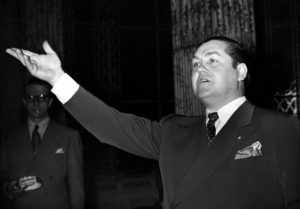
On This Day: An Extensive Look at Jussi Björling’s Career At the Metropolitan Opera
By David SalazarOn Feb. 5, 1911, the world was given the great gift that was Jussi Björling. The Swedish tenor became an icon throughout his career, his perfect vocal control a defining feature of his extensive career.
Björling is in many ways synonymous with the Metropolitan Opera, becoming one of the company’s principal artists throughout the 1940’s and 50’s singing a wide range of repertoire.
Early Years
He made his debut on Nov. 24, 1938 in Puccini’s “La Bohème,” a role he would sing with the company 15 times, the last performance coming on Feb. 1, 1954.
On Dec. 2, 1938, he would take on Verdi’s “Il Trovatore” for the first of 17 performances at the Old House.
The following season, Björling would sing “Faust,” “Rigoletto” and “La Bohème” for a total of five performances.
The 1940-41 season was marked by his first ever opening night, a performance of “Un Ballo in Maschera.” The entire run would last five performances that season; he would sing the opera a total of 14 times at the Met. During that season he alternated “Ballo” with performances of “Il Trovatore” and “Faust. At the end of the season, Björling took on “Rigoletto” for two performances; that role was sung 14 times during his tenure with the company.
He would be a be absent in New York until November 1945, when the Met would get him performing as much as humanely possible. That season the Swedish tenor sang four presentations of “Rigoletto,” four of “Tosca,” three of “La Bohème” and one of “Un Ballo in Maschera.” He also performed in a Gala event on Jan. 1, 1946.
During 1946-47, Björling sang “La Bohème,” “Faust,” “Roméo et Juliette” and “Il Trovatore” for a total of seven performances.
The following season saw the tenor sing his first “Cavalleria Rusticana and Pagliacci” at the Met, a brief one performance showcase on Dec. 31, 1947; he also sang it on tour that year in Missouri. He also supplied more performances in “Il Trovatore,” “Rigoletto,” “La Bohème,” “Tosca” and “Un Ballo in Maschera.” He sang a total of 18 performances, including an extensive tour around the United States.
The 1948-49 season saw the tenor sing more “Trovatore,” “Bohème” and “Rigoletto.”
He kicked off the 1949 season with a new production of “Manon Lescaut” alternating that work with “Tosca” and one turn as the Duke in “Rigoletto” on tour.
Bing Years
He got his second opening night on Nov. 6, 1950 in a new production of “Don Carlo,” which he sang eight times that season. He also performed “Faust” on five occasions in the 50-51 season and also fit in two performances in “Manon Lescaut.”
The following year he continued his work as “Don Carlo” and in 1952-53 he sang but two performances.
He got another opening night the following year, singing “Faust” in a new production alongside Victoria de Los Angeles.
After missing the 1954-55 season, he returned for “Ballo,” “Manon Lescaut,” an “Italian Gala,” “Tosca” and a guest performance in “Die Fledermaus.”
End of his Met Tenure
As his Met career wrapped up in the latter years, his appearances grew smaller and smaller. In 1956-57, he appeared five times. He was not in the 1957-58 season and only appeared in for a National Council Concert in 1958-59. His final season featured eight performances in three different operas, his final ever performance at the Met coming on Dec. 22, 1959 in the “Cav-Pag” combo.
His most performed works at the opera house were “Tosca” and “Trovatore,” which he took on 17 times throughout his career.


